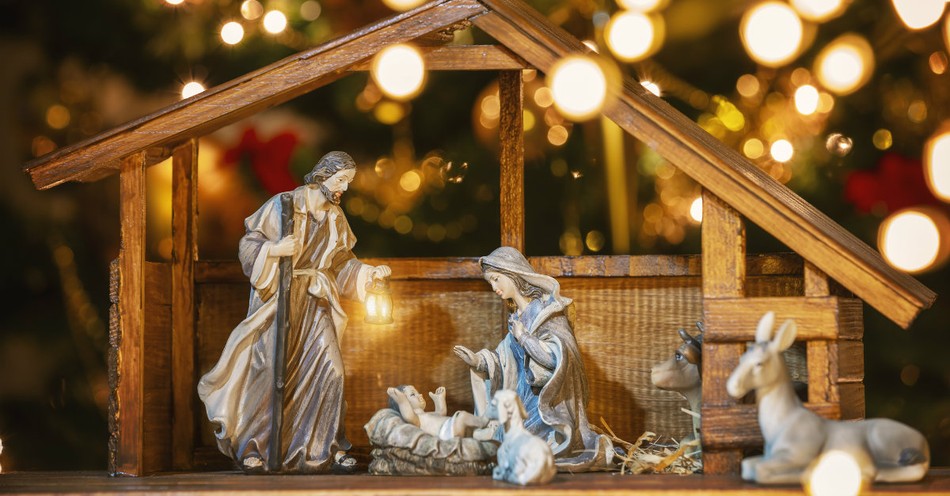A creche, or a nativity scene, brings the Christmas story to life in our homes. It captures the wonder and story of Christ’s birth. Whether we arrange a simple set of figures, a well-crafted scene, or even a cartoon version, the creche offers a visual and tangible way to connect with the meaning of Christmas—Jesus coming to be with us.
Each figure in the scene tells a story of faith, hope, and love. Mary, Joseph, shepherds, wise men, and animals all gather around the baby Jesus. Some families even make their own, a powerful tradition to teach children the story of Jesus and why we give gifts.
The nativity scene is also called a creche. Looking at the history of the word teaches us important truths regarding the Gospel and creative ways to express it.
What are the Roots of the Creche?
The word “creche” comes from the French language, meaning “manger” or “crib,” and it originally described a nursery that cared for infants. For Christians, a creche refers more to the nativity scene.
The custom of depicting a nativity scene traces back to St. Francis of Assisi in 1223. He wanted to help his followers visualize the birth of Christ. In those days, many people couldn’t read, so the church often used the arts to tell the story of Jesus, whether in paintings, songs, or architecture. To bring the nativity story to life, Francis set up a manger scene in a cave in the Italian village of Greccio. He invited the villagers to participate in a re-enactment of the birth of Jesus. This live nativity scene included real animals, and the people dressed as the nativity characters. St. Francis’ nativity scene had such an impact that other displays popped up across Italy, Europe, and the world.
The creche tradition continued to evolve over the centuries as it spread to other cultures, which further adopted it. Italian artists started crafting elaborate figures made of clay, wood, or wax, depicting the different characters from the biblical account. By the 18th century, these figures became more popular in the city of Naples, where creches became large and detailed. They would include the biblical characters along with the entire village. The scenes reflected Italian village life and the townsfolk, which brought a personal touch to the scenes.
Nativity scenes, known in France as creches, gained popularity during the French Revolution, a resistance movement when religious displays were forbidden. The Revolution sought to overturn all traditional systems of power, including religion. To keep the tradition alive in their homes, French Catholics created small, clay figures called “santons” depicting the nativity characters. These figures also began to include local tradespeople and everyday villagers. The creativity and resilience became part of the French creche tradition and helped preserve their beliefs during oppression and persecution.
For the Spanish, especially in Catalonia, nativity scenes (or “belenes”) were detailed and incorporated scenes from daily life. Beyond the original nativity, their scenes had entire Spanish towns with homes, shops, and markets. This tradition carried over to Latin America where creches are still part of Christmas celebrations. Each Latin American country has developed unique nativity styles to reflect its own culture and materials. As an example, Mexican nacimientos might have brightly painted clay figures.
What is the Connection Between the Creche and the Nativity Scene?
For the original during St. Francis’ time, these creches bridged the distance between an old story from a book and peoples' everyday existence. The people dressed up as characters, and they used local animals, all a profound and simple truth of how they should live the Good News in their context. Although Christ was born centuries before, the truth of his coming remains and continues eternally. By embodying Mary, Joseph, the shepherds, or the wise men, villagers could personally experience the Christmas story and live out the hope, peace, and joy Jesus’ birth brought to us. The original creche invited them to bring God’s redemptive story to life in their own compassion and generosity.
As the creche developed in various cultures, it would include the local towns and native animals, mixing the Christmas story with the unique parts of their daily life. They brought Bethlehem and Israel into a recreation of their own homes and farms, visually and creatively connecting the birth of Christ to elements familiar to them. This creative interpretation showed how Christianity was part of their whole lives. The nativity wasn’t just a story for the church but for each home and community. Through their creches, families could see their daily work, community connections, and even their animals as part of a larger story of Christ’s teachings.
When the French Revolution banned public religious displays, Christians turned to creches to keep their faith in a visible way. Setting up creches in their homes helped them honor the nativity privately and stand firm against the persecution of the day. The creche became a powerful symbol of resistance and hope. This resistance connects with the Gospel message of hope for the oppressed and persecuted, reminding us how Jesus was born as a Jew under Roman oppression. He arrived in a world filled with injustice, and through his life, he preached a message of comfort and freedom for the slave and marginalized.
How Did English Countries Start Adopting the Creche?
As the European Christian traditions traveled, they eventually found their way into English-speaking Protestant areas. However, the Reformation led many Protestants to distance themselves from what they saw as Catholic customs, leading to a slow and selective adoption of the creche. By the 18th and 19th centuries, with increased trade between England and the rest of Europe, nativity scenes gained more traction in England and the British colonies.
Queen Victoria and her husband, Prince Albert (German-born), celebrated in ways influenced by wider European customs, including Christmas trees and a basic nativity scene. Their family Christmas decorations and celebrations transferred to the British middle and upper classes. As German, Italian, and French customs became more common, more English families adopted the full nativity scene, usually calling them “mangers” or “nativity displays,” but they also used the word “creche.”
In the U.S., the creche became popular in the 19th and 20th centuries, first through missionaries and then European immigrants. Communities tried to bring more meaning to Christmas, and especially Italian and French immigrants brought the creche customs with them. Churches and Catholic schools spread the tradition, as they would set up bigger nativity scenes to teach children the story of Jesus' birth in a visual way. By the 1900s, public nativity scenes included life-sized figures in town squares or churchyards.
Families started incorporating smaller creches into their holiday decorations, even passing down nice sets through generations. Some scenes include unique cultural adaptations, with figures dressed in local or ethnic clothing.
What Can Christians Learn from the Creche?
The creche serves as a visual representation of Jesus’ birth, inviting us to remember how “the Word became flesh and made his dwelling among us” (John 1:14). This imagery in the home reminds us of Christ’s simplicity and humility. He didn’t come into the world in worldly splendor but as a vulnerable and physically helpless infant in a stable. The characters surrounding the baby help us to meditate on how Jesus’ life means transformation for all people regardless of race, gender, or class.
Traditions like the creche also hold cultural and historical meaning, encouraging us to affirm the roots of our faith. We shouldn’t take our background for granted. Proverbs 22:28 urges us, “Do not move an ancient boundary stone set up by your ancestors.” The Bible encourages us to honor past generations and their traditions. The creche, with its amazing historical background, reminds us how faith spans centuries and connects us to other times and places. Through understanding the development of the creche from St. Francis to today, we see ways traditions can emerge from devotion, and it gives our own participation more purpose.
On a wider level, how the creche evolved should open us to dignifying how other cultures express biblical truth through their own adaptations and traditions. Paul taught the early church to value the diversity within the Body of Christ, since “there is neither Jew nor Greek, slave nor free, male nor female, for you are all one in Christ Jesus” (Galatians 3:28). Different cultural interpretations of the creche, such as those from Latin America or African nativity scenes with local animals and clothing, bring more richness to the Christian faith. These diverse expressions show that the message of Jesus’ birth transcends one culture or geographical region. Each culture can celebrate in personal and relevant ways.
With this in mind, we should consider the value of creating new traditions to communicate biblical truth to current generations. While the creche is almost universal now, at one point it didn’t exist. As the world changes, so do the ways people express their faith. By developing new traditions, we can keep the message of the Gospel alive and relevant through modern art, community service projects, or digital representations. As with the development of the creche, faith can be expressed creatively without losing its core message.
The creche is a living and changing tradition. It encourages us to stay grounded in the Gospel and our faith traditions while also embracing new ways to share the Gospel.
Peace.
Photo credit: ©Getty-manaemedia




.jpg)